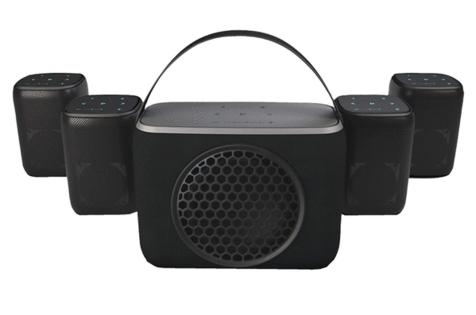Gadgets: This sound system has it all
Published in Science & Technology News
I'm unsure which feature of Rocksteady Audio's Rocksteady Stadium 2.0 speaker system is the best: the sound, portability or how easily it can be expanded. After using the sound system, you'll see that it encompasses everything.
The extra features might be great, but the sound is most important, and boy, the Rocksteady Stadium speaker system delivers. Inside each satellite speaker is a dual driver system, including a powered tweeter, a mid-bass driver and dual bass drums.
Each speaker has a 30 mm 10-watt tweeter, a 70 mm 20-watt mid/bass driver, and two 74 mm bass radiators for a total output of 30 watts. Adding the Rocksteady stadium subwoofer makes this a complete system. It has a 130 mm bass driver and 170 mm by 115 mm bass radiator for a total output of 30 watts.
The sound is exceptional when cranking up the audio to tailgate or house party levels, using it as background music, or with an outdoor theater. What speaker doesn't advertise itself as the best of the best? The Rocksteady Stadium 2.0 system delivers precisely what Rocksteady touts. The Rocksteady site states, "These speakers allow every detail of your favorite songs to shine through with industry-best performance," which is true to the word.
Rocksteady Stadium 2.0 speakers work with one speaker as host and the other speakers and subwoofer connecting to it. As with most people, I don't read the setup instructions. But in this case, if you're unfamiliar with a host speaker system, a setup video explains it and gets you playing in seconds.
Once the host speaker is on, pair your phone or the music source via Bluetooth (v5.0). To add speakers or a subwoofer, power them on and press the stadium button. In a few seconds, they will be connected. Then, every subsequent time they are turned on, they auto-reconnect instantly and play with perfection.
There are two modes: long-range (mono) or stereo. I kept them in stereo. The long-range mode is the default. To switch modes, hold the play button on the host speaker for 5 seconds. Since the host speaker is in control, the rest of the speakers will also turn off when you turn it off.
It's also worth noting that there is no limit to the number of speakers or subwoofers you can have. If your house has 10 rooms and you want two in each room, buy 20 speakers. But keep the host speaker centrally located to reach them all. Rocksteady recommends using the long-range mode to spread the speakers into a larger area.
Depending on your setup and the number of speakers, you can choose how you want the channels set up. Each speaker can be designated for the left, right or both channels.
You can see the battery level in each speaker by pressing the volume button. If they stay inactive for 30 minutes, they will turn off to save battery power. They charge with the included USB-C cable and will also play while charging. Each speaker has a 5000 mAh Lithium-Ion battery rated for up to 30 hours of continuous play. The subwoofers have a 15,000 mAh battery that lasts 30 hours.
All the controls mentioned, along with track selection, play/pause, and volume, are on the top. On the side is the power button and a mounting plate. Under a panel cover is the audio channel selector (L/R/both) and the USB-C and auxiliary ports. Each speaker measures 4.3 by 4.3 by 6 inches and weighs 2.2 pounds.
The subwoofer's controls and ports are similar. It measures 4.3 by 8.7 by 6.4 inches and weighs 4.7 pounds. The subwoofer has a carrying strap. Much to my delight, there are no microphones in the speakers or subwoofer, so you don't have to take your cell phone calls in stereo when guests are present.
Rocksteady is available in various speaker and subwoofer packages. Individual speakers are $149.99 each, and the subwoofer is $179.99. The Rocksteady Stadium 2.0 Speakers and Subwoofer pack is $399.99 and includes a free carry bag.
https://rocksteadyaudio.com
©2025 Gregg Ellman. Distributed by Tribune Content Agency, LLC.










Comments